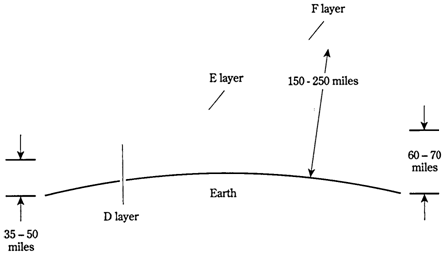Sky-wave EM propagation
The earth’s ionosphere, at the altitudes from around 35 miles to 250 miles, has a great effect on the EM waves at frequencies below around 100 MHz.The ionosphere comprises of 3 layers, called as D layer, and F layer. E layer. The layers form at various altitudes, with D layer lowest and F layer highest .The D layer absorbs radio waves at the frequencies below around 7 MHz. The E and F layers return radio waves to earth by a process known as ionospheric refraction.

Figure--Simplified rendition of the ionosphere.
The D layer is dense during the daylight and vanishes at night. This makes long distance sky-wave propagation poor during daytime and good at night on frequencies below around 7 MHz. The D layer’s disappearance at the dusk is responsible for dramatic change in behavior of the AM broadcast band (535 kHz to 1. 605 MHz) which occurs after sunset.
The E layer varies in density with 11-year sunspot cycle. The largest ionization is during peak sunspot years (that is 1979, 1990, 2001, etc.) and least is during slack years. Solar flares cause E layer to form dense regions which return radio waves to earth at frequencies as high as 100 MHz. The E layer can generate communications over distances of hundreds or thousands of miles.
The F layer returns radio waves at all the frequencies up to a certain maximum, called as maximum usable frequency (MUF). The MUF varies depending on sunspot cycle and on day-to-day solar activity. Reliable communications can be had up to about 7 MHz during night and 15 MHz during day when sunspot activity is minimum; this increases to 20 MHz at night and 50 MHz during day when sunspot numbers are maximum.All ionospheric modes are called as sky-wave propagation. This is mode responsible for worldwide shortwave communications and for the nighttime AM broadcast reception over the thousands of miles